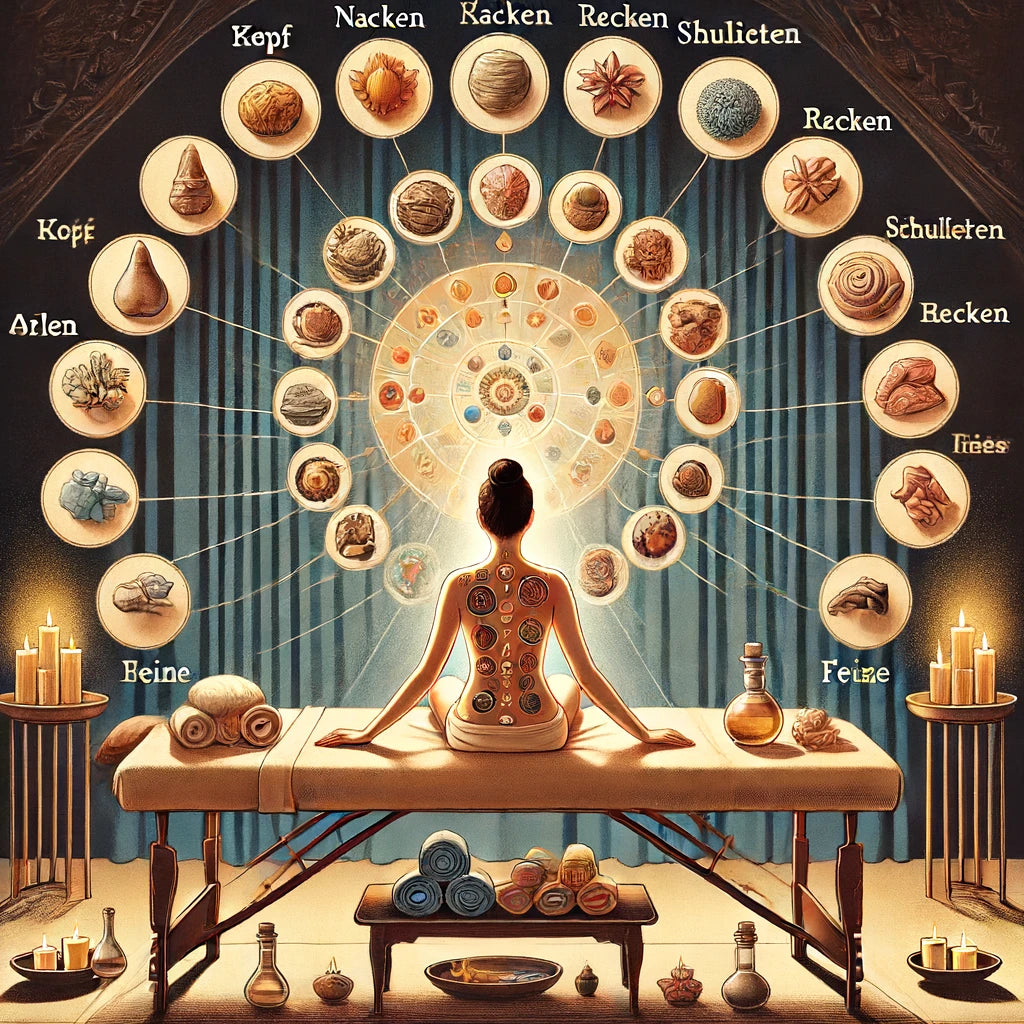
Which massage involves massaging everything?
Have you ever wondered which type of massage pampers your entire body from head to toe? If so, you've come to the right place! In this article, we'll take a closer look at different types of massage and clarify which massage truly massages "everything." Prepare to be surprised and find out which massage offers you the ultimate in relaxation.
Summary/TLDR
In this article, you'll learn which massage types target your entire body and what benefits they offer. From the classic full-body massage to the Ayurvedic Abhyanga massage and Thai massage, we present the best massages that offer a comprehensive treatment. Read on to find out which massage is best for you.
The classic full body massage
What is a classic full body massage?
The classic full-body massage is probably the most well-known form of massage. It typically includes all major muscle groups in the body, from the feet and back to the shoulders and neck.
Benefits of full body massage
- Relaxation : This type of massage helps to reduce stress and relax the body and mind.
- Promotes blood circulation : Targeted massage techniques improve blood circulation, which in turn supports the supply of nutrients and oxygen to the muscles.
- Pain relief : Muscle tension and pain can be effectively relieved through a full body massage.
The Ayurvedic Abhyanga massage
What is Abhyanga massage?
Abhyanga massage is a traditional Ayurvedic massage in which the entire body is massaged with warm, healing oil. It is considered one of the most comprehensive and holistic forms of massage.
Benefits of Abhyanga Massage
- Detoxification : The warm oil penetrates deep into the skin and helps remove toxins from the body.
- Rejuvenation : The massage promotes the regeneration of the skin and gives it a youthful appearance.
- Holistic healing : It has a healing effect not only on a physical level, but also on a mental and emotional level.
The Thai massage
What is Thai massage?
Thai massage, also known as "yoga for lazy people," combines acupressure, stretching, and meditation techniques. The masseur uses hands, elbows, knees, and feet to treat the entire body.
Benefits of Thai massage
- Increased flexibility : The intensive stretching exercises increase the flexibility of the muscles and joints.
- Energy flow : It promotes the flow of energy in the body and can release blockages.
- Whole body relaxation : The combination of pressure and stretching ensures deep relaxation.
The hot stone massage
What is hot stone massage?
In a hot stone massage, smooth, heated stones are placed on specific points on the body. The hot stones are also used to massage the muscles to release deep-seated tension.
Benefits of hot stone massage
- Deep relaxation : The warmth of the stones penetrates deep into the muscles and promotes relaxation.
- Pain relief : This form of massage can be very effective, especially for chronic pain.
- Stress reduction : The combination of heat and massage techniques helps to reduce stress.
The Lomi Lomi Nui Massage
What is Lomi Lomi Nui massage?
This Hawaiian massage style is known for its flowing, rhythmic movements that envelop the entire body. It is often described as a dance on the body and utilizes the forearms, hands, and elbows.
Benefits of Lomi Lomi Nui Massage
- Whole body harmony : It promotes a feeling of wholeness and harmony in the body.
- Emotional Healing : This massage can release emotional blockages and create a deep sense of inner peace.
- Rejuvenation : The massage revitalizes and radiates the skin.
1. What are the advantages of a full-body massage compared to a partial-body massage?
Introduction
Full-body massages and partial-body massages are two of the most common types of massage offered, but which is better for you? In this article, we'll explore the benefits of full-body massage versus partial-body massage and help you decide which type of massage best suits your needs.
The full body massage: An overview
A full-body massage involves the treatment of all major muscle groups from head to toe. It is often described as a complete relaxation experience that offers both physical and mental benefits. This type of massage can incorporate various techniques, including classical massage, deep tissue massage, and other specialized methods.
Benefits of full body massage
1. Holistic relaxation: A full-body massage promotes total relaxation because it engages all muscle groups. The even distribution of massage strokes achieves comprehensive relaxation throughout the entire body, which is particularly helpful for reducing stress and tension.
2. Improved circulation: Stimulating all areas of the body promotes blood circulation, resulting in a better supply of oxygen and nutrients to the muscles. This can accelerate injury healing and improve overall health.
3. Pain and tension relief: By working all muscle groups, deep-seated tension and chronic pain can be effectively relieved. This is especially beneficial for people suffering from general muscle pain.
4. Improved skin health: Using massage oils in a full-body massage can moisturize the skin and improve its texture. The massage also stimulates lymphatic drainage, which contributes to detoxification.
Comparison to partial body massage
Targeted treatment: Partial body massages focus on specific problem areas such as the neck, back, or legs. This can be especially useful if you have specific problems that require quick relief.
Shorter duration: Partial body massages are generally shorter and therefore easier to fit into a busy schedule. They're a good option if you're short on time but still want the benefits of a massage.
More cost-effective: Because they take less time, partial body massages are often less expensive than full body massages. This can be a deciding factor if you're on a tight budget.
Conclusion
Both types of massage have their specific benefits. If you're looking for comprehensive relaxation and treatment of your entire body, a full-body massage is the ideal choice. Partial-body massages, on the other hand, are perfect if you need targeted relief for specific problem areas. The NAIPO massage chairs and the NAIPO Relax Lounge offer a cost-effective alternative to traditional massage, allowing for both types of treatments in the comfort of your own home.
2. How does the technique of full body massage differ from other types of massage?
Introduction
The technique of full-body massage differs significantly from other types of massage. In this article, we will examine the specific techniques and methods of full-body massage compared to other common forms of massage and highlight what makes this type of massage so special.
Techniques of full body massage
1. Classic massage techniques: The full-body massage uses classic massage techniques such as kneading, stroking, and tapping to loosen muscles and promote circulation. These techniques are designed to relax and revitalize the entire body's muscles.
2. Deep tissue massage: A popular technique within full-body massage is deep tissue massage. This uses more intense pressure to release deep-seated muscle tension and improve circulation in the deeper tissue layers.
3. Combination of techniques: A full-body massage can combine elements from different massage styles to provide a customized treatment. This includes techniques from Swedish massage, Shiatsu massage, and reflexology.
Differences to other types of massage
Specialized massages: In contrast to full-body massages, specialized massages such as sports massages or pregnancy massages focus on specific needs and problem areas. These massages often use specific techniques optimized for the respective target group.
Localized massages: Partial body massages, such as neck or back massages, focus exclusively on specific areas of the body. The techniques here are often more intensive and targeted to relieve specific discomforts.
Energy work: Techniques such as Reiki massage or Thai massage often include elements of energy work. These massages aim to harmonize the flow of energy in the body and open blocked energy channels.
Conclusion
The full-body massage is characterized by its comprehensive treatment of all muscle groups and the combination of various techniques. This distinguishes it from other types of massage, which either target specific problems or use specialized techniques. For holistic relaxation and revitalization of the body, the full-body massage is ideal. NAIPO massage chairs and the NAIPO Relax Lounge offer a great way to experience these diverse techniques affordably and comfortably in the comfort of your own home.
3. Which massages are best for relieving muscle tension throughout the body?
Introduction
Muscle tension can significantly impact everyday life. In this article, we explore the best massages for relieving tension throughout the body and show how you can achieve long-term relaxation and pain relief through targeted massage techniques.
The classic full body massage
Benefits: The classic full-body massage is excellent for relieving general muscle tension. The combination of kneading, stroking, and pressure techniques targets all muscle groups, resulting in comprehensive relaxation.
The deep tissue massage
Technique: This massage type goes deeper than traditional massage and focuses on the deep layers of muscle tissue. Slow, firm pressure and specific grips effectively release deep-seated tension.
Application: Particularly suitable for people with chronic pain and persistent muscle tension. It is more intense and may be painful at first, but the long-term benefits are significant.
The trigger point massage
Technique: This method involves applying targeted pressure to specific points in the muscle tissue, called trigger points. These points are often the cause of pain and tension in other areas of the body.
Benefits: Treating trigger points can release tension and break pain cycles, leading to a significant reduction in muscle pain.
The Thai massage
Technique: Thai massage combines stretching techniques and acupressure. The masseur uses hands, elbows, knees, and feet to apply pressure to specific body points while simultaneously stretching the body.
Benefits: It improves flexibility and relieves tension through a deep, holistic treatment. This method is particularly effective for chronic tension and stiff muscles.
The hot stone massage
Technique: Heated stones are placed on the body and used for massage. The heat penetrates deep into the muscles, promoting circulation and relaxation.
Benefits: The combination of heat and massage techniques can relieve particularly stubborn tension and provide deep relaxation.
Conclusion
There are several effective massage techniques for relieving muscle tension throughout the body. Classic full-body massage, deep tissue massage, trigger point massage, Thai massage, and hot stone massage are all excellent options. Each technique offers specific benefits and can be customized to your individual needs. NAIPO massage chairs and the NAIPO Relax Lounge offer a cost-effective and comfortable alternative to professional massage, helping you relieve tension in your daily life.
4. What role does the use of oils play in full body massage?
Introduction
Oils are an integral part of many massages and offer a variety of benefits. In this article, you'll learn about the role oils play in full-body massage and how they can enhance the effects of the massage.
Types of massage oils
1. Base oils: Base oils such as almond oil, jojoba oil, and grapeseed oil are commonly used. They are light, well-tolerated, and quickly absorbed into the skin.
2. Essential oils: Essential oils such as lavender, peppermint, and eucalyptus are often added to base oils for additional therapeutic effects. They offer aromatherapy benefits and can promote relaxation and healing.
Benefits of using oils
1. Increased lubrication: Oils reduce friction between the massage therapist's hands and the client's skin. This allows for smoother, more fluid movements and prevents skin irritation.
2. Skin care: Massage oils provide the skin with moisture and nutrients. This can improve skin texture, prevent dryness, and keep the skin supple.
3. Aromatherapy: The addition of essential oils can enhance the massage with aromatherapy. Lavender oil, for example, can have a calming effect, while peppermint oil invigorates and refreshes the senses.
4. Anti-inflammatory properties: Some oils, such as arnica oil and St. John's wort oil, have anti-inflammatory properties that can help reduce pain and swelling.
Use of oils in full body massage
Preparation: The massage therapist often warms the oil slightly to ensure a pleasant feeling on the skin. The oil is then applied to the skin and spread evenly.
Techniques: The oils allow the masseur to glide over the skin with gentle, flowing movements. This is especially important for techniques such as stroking and kneading.
Conclusion
The use of oils in a full-body massage plays a crucial role in the effectiveness and well-being of the massage. They increase lubrication, nourish the skin, and provide additional therapeutic benefits through aromatherapy and anti-inflammatory properties. NAIPO massage chairs and the NAIPO Relax Lounge also offer the option of using oils to make the massage experience even more enjoyable at home.
5. How long does a typical full body massage take and what can I expect during the session?
Introduction
The duration and procedure of a full-body massage are important aspects you should know before undergoing such a treatment. In this article, you'll learn how long a typical full-body massage lasts and what to expect during the session.
Duration of a typical full body massage
Standard duration: A typical full-body massage usually lasts between 60 and 90 minutes. This time allows the massage therapist to thoroughly treat all major muscle groups and ensure complete relaxation.
Extended sessions: In some cases, a full-body massage can last 120 minutes or longer, especially if special techniques are used or additional relaxation phases are planned.
Course of the meeting
1. Welcome and Preparation: At the beginning of the session, the massage therapist will conduct a brief conversation with you to discuss your needs and any health concerns. Afterward, you will be asked to lie down on the massage table and relax.
2. Warm-up: The session often begins with gentle caresses to prepare you for the massage and create a relaxing atmosphere. The massage therapist may use a warm towel or aromatherapy to promote relaxation.
3. Main part of the massage: The masseur will systematically work all major muscle groups. This usually includes the back, shoulders, arms, legs, feet, and neck. Various techniques such as kneading, stroking, and tapping are used to relieve tension and improve circulation.
4. Specific treatments: Depending on your individual needs, the massage therapist can focus on specific problem areas, such as tense shoulders or sore legs, using targeted techniques such as deep tissue massage or trigger point therapy.
5. Conclusion and relaxation: At the end of the massage, a relaxation period is often planned for you to allow the relaxation to sink in. The masseur can show you gentle stretching exercises or offer recommendations for at home to prolong the effects of the massage.
Expectations during the meeting
Comfort and privacy: Throughout the entire session, you will feel comfortable and safe. Your privacy will be respected, and only the areas of the body being treated will be exposed.
Communication: It's important to communicate with your massage therapist during the massage. If you experience any pain or discomfort, please report it immediately so the pressure or technique can be adjusted.
Relaxation: Use this time to completely unwind. Close your eyes, breathe deeply, and leave everyday life behind you.
Conclusion
A typical full-body massage lasts between 60 and 90 minutes and offers comprehensive treatment of all major muscle groups. The session is designed to ensure maximum relaxation and well-being. If you can't regularly incorporate a professional massage into your daily routine, NAIPO massage chairs and the NAIPO Relax Lounge offer an excellent and cost-effective alternative for at home, allowing you to regularly reap the benefits of a full-body massage.
Conclusion
There are many different types of massages that massage the entire body and provide comprehensive relaxation. Whether you choose a classic full-body massage, the Ayurvedic Abhyanga massage, the Thai massage, the hot stone massage, or the Lomi Lomi Nui massage – each has its own special benefits. Try different massages and find out which one suits you best and offers the best relaxation for your body and mind.
FAQs
1. How often should I have a full body massage?
It depends on your personal needs, but many experts recommend enjoying a full body massage at least once a month for optimal results.
2. Can I have a full-body massage if I have health problems?
It's always advisable to consult your doctor beforehand, especially if you have any health problems. Some types of massage may be helpful for certain conditions, while others should be avoided.
3. Which massage is best for stress relief?
The classic full-body massage and the Abhyanga massage are particularly suitable for reducing stress and promoting deep relaxation.
4. Can I combine several types of massage?
Yes, many massage therapists offer combination massages that incorporate elements of different techniques. This can be particularly effective for addressing different needs simultaneously.
5. What should I consider before a massage?
Make sure you're well hydrated and avoid heavy meals immediately before your massage. Inform your massage therapist about any health issues or pain you may have so the massage can be adjusted accordingly.







Leave a comment
This site is protected by hCaptcha and the hCaptcha Privacy Policy and Terms of Service apply.